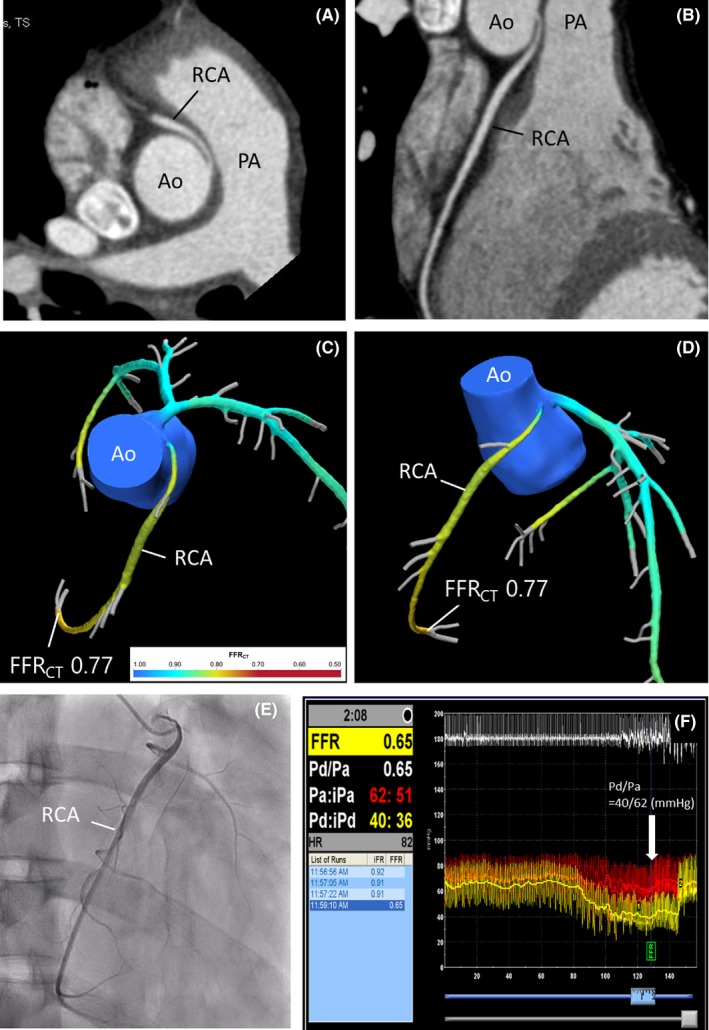Key Clinical Message
A right coronary artery of anomalous origin is rare congenital anatomy that can be fatal. CT angiography is an excellent tool for its anatomical assessment. Noninvasive CT‐based fractional flow reserve measurement can additionally evaluate the functional severity of coronary stenosis and is potentially useful for evaluating coronary anomalies.
Keywords: computed tomography, coronary artery anomaly, fractional flow reserve, ischemia
1. CASE REPORT
A 26‐year‐old man who was referred to our hospital presented with a clinical history of exercise‐related syncope. Coronary CT angiography revealed an anomalous aortic origin of the right coronary artery (RCA) from the left coronary ostium. The proximal portion of the RCA seemed to be coursing along the aortic vessel wall before running between the aorta and pulmonary artery (Figure 1A,B). CT‐based fractional flow reserve (FFRCT) (HeartFlow, Redwood, CA, USA) in the RCA was 0.77 (ischemic cutoff ≤0.8), suggesting significant ischemia (Figure 1C,D). Coronary angiography suggested the presence of a slit‐like ostium of the anomalous RCA (Figure 1E). Invasive FFR evaluation confirmed significant ischemia (Figure 1F). The treating physicians decided on surgical treatment.
Figure 1.

A‐B, Axial and sagittal coronary CT angiography. C‐D, FFRCT. E, Coronary angiography, right anterior oblique projection. F, Invasive FFR [= distal coronary/aortic pressures ratio (Pd/Pa)] measured with adenosine 140 μg/kg/min i.v. administration (arrowhead). Ao, aorta; FFRCT, CT‐derived fractional flow reserve; PA, pulmonary artery; RCA, right coronary artery
An anomalous origin of the RCA from the left sinus of Valsalva is rarely seen congenital anatomy. Although the presentation is usually silent, clinical manifestations may include aborted sudden death, chest pain, arrhythmia, and/or exercise‐induced presyncope or syncope. The FFRCT, derived from the usual data set from coronary CT angiography, was recently developed to evaluate functional ischemia of the coronary artery.1 In the present case, FFRCT revealed ischemia in an anomalous coronary artery, which was confirmed by the invasive FFR measurement. Thus, the FFRCT technique has potential for innovation in the assessment of anomalous coronary arteries.
AUTHORSHIP
All authors made substantial contributions to the preparation of this manuscript. TMiy, TMik, KO, NA, and AW: involved in the conceptualization, preparation, writing, and review of this manuscript. HI: involved in the conceptualization, writing, and review of this manuscript.
CONFLICT OF INTEREST
The authors declare that there is no conflict of interest regarding the publication of this article.
Miki T, Miyoshi T, Watanabe A, Osawa K, Amioka N, Ito H. Anomalous aortic origin of the right coronary artery with functional ischemia determined with fractional flow reserve derived from computed tomography. Clin Case Rep. 2018;6:1371–1372. https://doi.org/10.1002/ccr3.1582
REFERENCE
- 1. Norgaard BL, Leipsic J, Gaur S, et al. Diagnostic performance of noninvasive fractional flow reserve derived from coronary computed tomography angiography in suspected coronary artery disease: the NXT trial (Analysis of Coronary Blood Flow Using CT Angiography: Next Steps). J Am Coll Cardiol. 2014;63:1145‐1155. [DOI] [PubMed] [Google Scholar]


